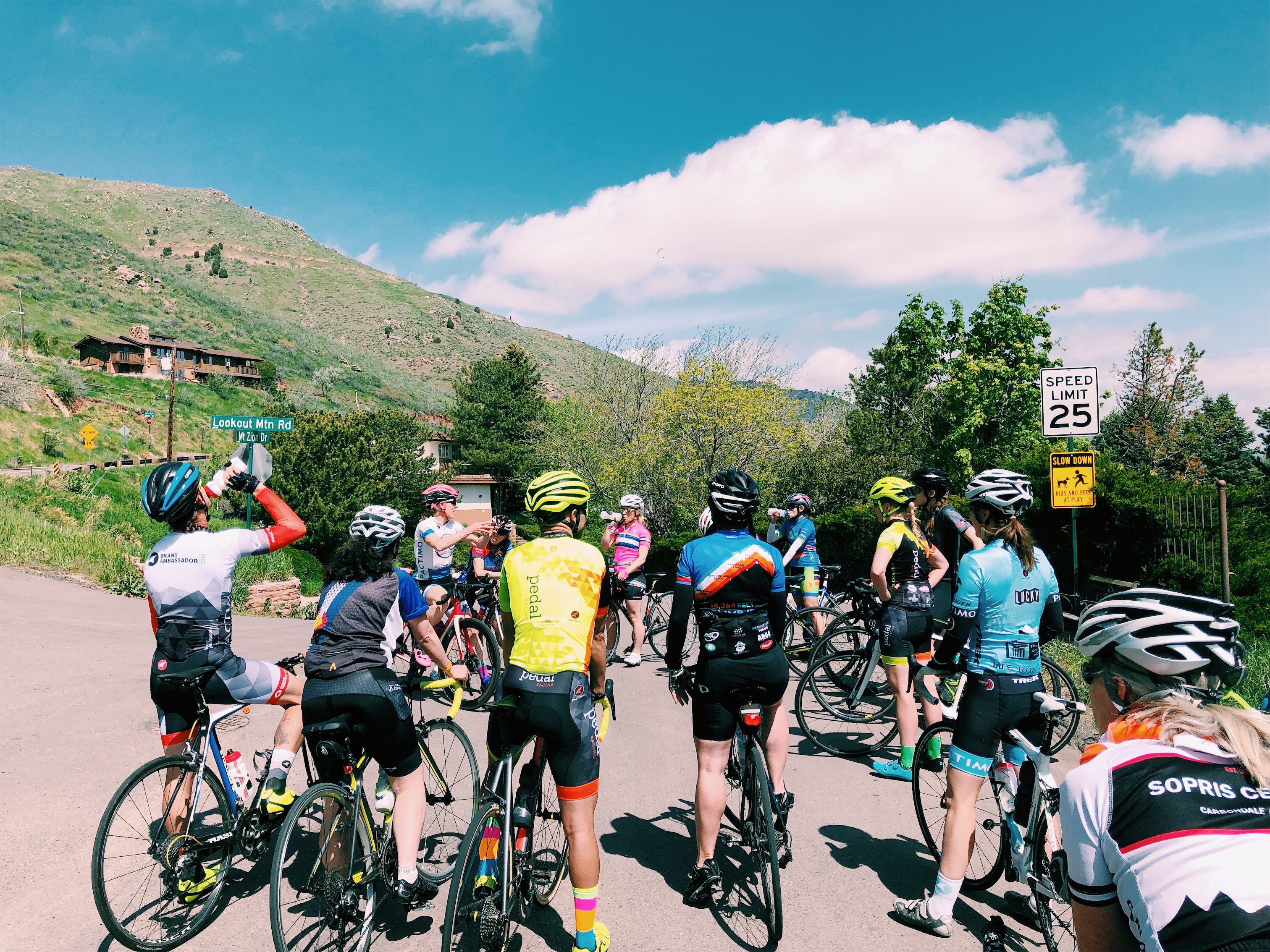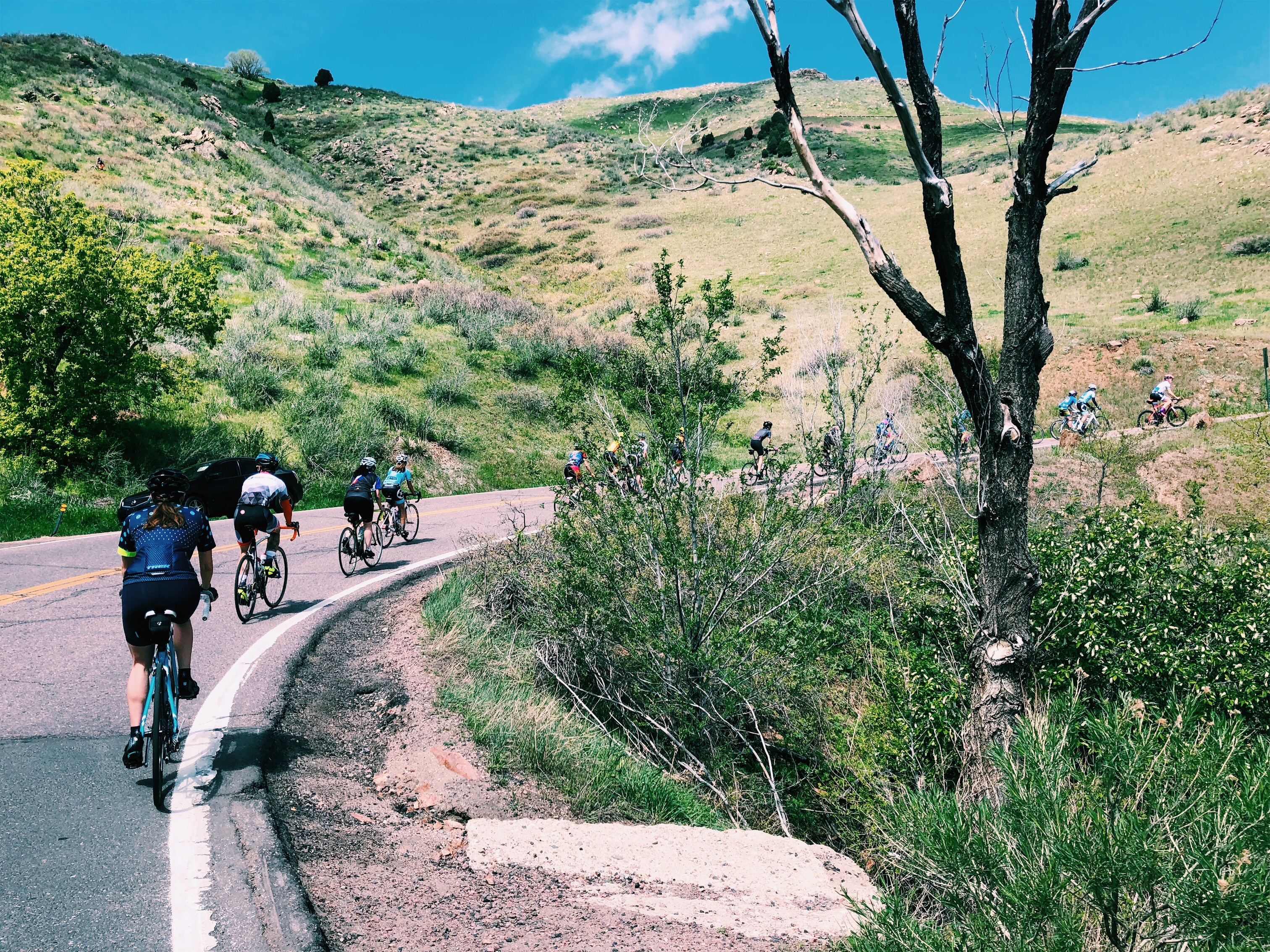You may see big improvements by attending a clinic when you’re first starting out racing, but how have you recently refined your skills? When’s the last time you properly stood on your bike and pulled your handlebars with your latissimus dorsi muscles? What was your saddle doing as you stood out of it? When’s the last time you climbed Lookout Mountain and methodically alternated between standing and sitting the whole climb?
As we become more experienced racers and bike riders, we assume clinics are for beginners. Stop. Always be learning.
This past Sunday, May 26th, BRAC held its second Women’s+ Clinic. Coach Alison Powers of ALP Cycles Coaching taught us hill climbing techniques to get us up to the top faster. I decided last minute to attend the clinic even though I already had two volunteers, Stephen and Marcus (pedal RACING team members), to help out. I get caught between burn out from managing the entire BRAC Women’s+ Bike Racing Initiative and feeling like I need to be at all the events to prove my dedication. Like being stuck between a rock and a hard place. Or, a cyclist who wants more women racing their bikes but needs to focus on her own training goals too.
My training for the day called for four hours of Zone 2. I knew my teammate, Brittney, signed up for the clinic. I asked if she’d like to commute to the clinic. So we did.
We got there early. Sixteen women signed up. I anxiously awaited their presence knowing some would flake. I hoped all sixteen would show. Five interested racers, four Cat 5 racers, and three Cat 4 racers showed. I was the only Cat 3 woman who was there.
This is where I get disappointed. From the survey BRAC conducted, there was an overwhelming ask for more women’s+-only clinics, women’s+ social rides, and mentors. I fought tooth and nail for a budget to provide that to Colorado women racers. There are roughly 500 or so women registered through BRAC. So where the fuck are they?
I also realize that just because it’s available doesn’t mean women will or have to show up. I understand we all have lives outside of bike racing and as amateur bike racers, tooling around in a circle for forty minutes may come second to other priorities. I’m also super grateful that we had anyone show up at all. It could have just been Alison and me twiddling our thumbs.
I think I get disappointed because I’ve spent an extraordinary amount of time and suffered through circular debates about this. I birthed this initiative in to existence. This has become an extension of me. It feels silly to say, in all honesty. I just want it to be successful. I also acknowledge my idea of success is probably unrealistic.
So, what did you miss out on by ditching the Hill Climb Clinic?

Importance of gearing
Just like oatmeal, beds, and gels: there’s a difference between too much and too little of something. Same goes for gearing: too easy or too hard of a gear and you’re likely to go slower. There’s a gear that’ll be just right to move you up the mountain faster.
The same goes for gearing between seated and standing: too easy of a gear when you stand and you’ll be spinning too fast to move. Shifting up a few gears while standing as you pedal helps to maintain cadence and power and push you forward. One of the exercises Alison instructed us to do was to practice pedaling while seated, shifting gears, and pedaling while standing.

Importance of positioning
When seated, typically, you’ll keep your hands on the hoods. When standing, you’ll want to move your body forward a little to allow for the saddle to move back and forth behind your legs. You’ll also want to pull with your upper body as you pedal standing. This will end up working your lats.
We also discussed positioning in a race and where the best lines are on hairpin turns.
We had made it about halfway up after discussing the different techniques of hill climbing. Then we rode the rest of the way to the top to practice on our own. Alison gave us a quick lesson on descending before we called it a day.
Our next clinic is Road Racing led by Inspired Training Center on June 23rd. You can find the details on the BRAC calendar or on our Facebook page.

Always-be-learning mindset
There are two kinds of mindsets: fixed and growth. A person with a fixed mindset believes that they can’t change, that they’re born with the abilities they currently have. Failing, to a fixed mindset type, is proof of their incompetence. Alternatively, someone with a growth mindset believes they can change, whether that’s a skill or personality trait, and they learn through failure.
The people who showed up to the clinic have a growth mindset. They went believing they’d learn a new skill and become a better hill climber. The people who saw the clinic and deliberately chose to do something else because they didn’t think they’d benefit from the clinic have fixed mindsets. They didn’t think they’d learn something.
Carol Dweck, author of Mindset: The New Psychology of Success, had this to say about people who have a growth mindset:
For twenty years, my research has shown that the view you adopt for yourself profoundly affects the way you lead your life. It can determine whether you become the person you want to be and whether you accomplish the things you value. How does this happen? How can a simple belief have the power to transform your psychology and, as a result, your life?
Believing that your qualities are carved in stone — the fixed mindset — creates an urgency to prove yourself over and over. If you have only a certain amount of intelligence, a certain personality, and a certain moral character — well, then you’d better prove that you have a healthy dose of them. It simply wouldn’t do to look or feel deficient in these most basic characteristics.
[…]
I’ve seen so many people with this one consuming goal of proving themselves — in the classroom, in their careers, and in their relationships. Every situation calls for a confirmation of their intelligence, personality, or character. Every situation is evaluated: Will I succeed or fail? Will I look smart or dumb? Will I be accepted or rejected? Will I feel like a winner or a loser? . . .
There’s another mindset in which these traits are not simply a hand you’re dealt and have to live with, always trying to convince yourself and others that you have a royal flush when you’re secretly worried it’s a pair of tens. In this mindset, the hand you’re dealt is just the starting point for development. This growth mindset is based on the belief that your basic qualities are things you can cultivate through your efforts. Although people may differ in every which way — in their initial talents and aptitudes, interests, or temperaments — everyone can change and grow through application and experience.
Do people with this mindset believe that anyone can be anything, that anyone with proper motivation or education can become Einstein or Beethoven? No, but they believe that a person’s true potential is unknown (and unknowable); that it’s impossible to foresee what can be accomplished with years of passion, toil, and training.
Don’t believe yourself when you blurt out loud, “I’m not a climber.” Change the way you talk to yourself. Having a fixed mindset, believing you’re too good for a clinic, is easy. Admitting you have weaknesses you can work on and taking steps to improve deficiencies is badass.

Improve your climbing
Over-Under Intervals
Riding below and above your FTP forces your body to handle changes in power output, mimicking race scenarios on long climbs.
Example Workout:
Warm-Up: 15-20 minutes
3×12 OU (2U, 1O) [2 mins under @ 86-90% FTP; 1 min over @ 102-105%+ FTP] x 4 = 12 minutes
6 mins Rest between intervals
Cool down: 15 minutes
Sweet Spot Training
Riding right below your FTP helps gradually increase it by challenging your body to maintain higher output for longer durations.
Example Workout:
Warm-Up: 15-20 minutes
3×20 mins @ 84-95% of FTP
10 sec. Sprint every 4 mins.
15 mins Recovery between intervals
Cool down: 15 minutes
Riding at your FTP
I see a lot of strong riders doing FTP intervals. This means riding at your FTP for a certain duration with rest in between. This also helps increase your FTP over time.
Example Workout:
Warm-Up: 15-20 minutes
3×15 @ FTP
5-10 minutes Recovery between intervals
Cool down: 15 minutes
Thanks to my patrons who make my writing possible. You can become part of our club here:

Dug this post?
